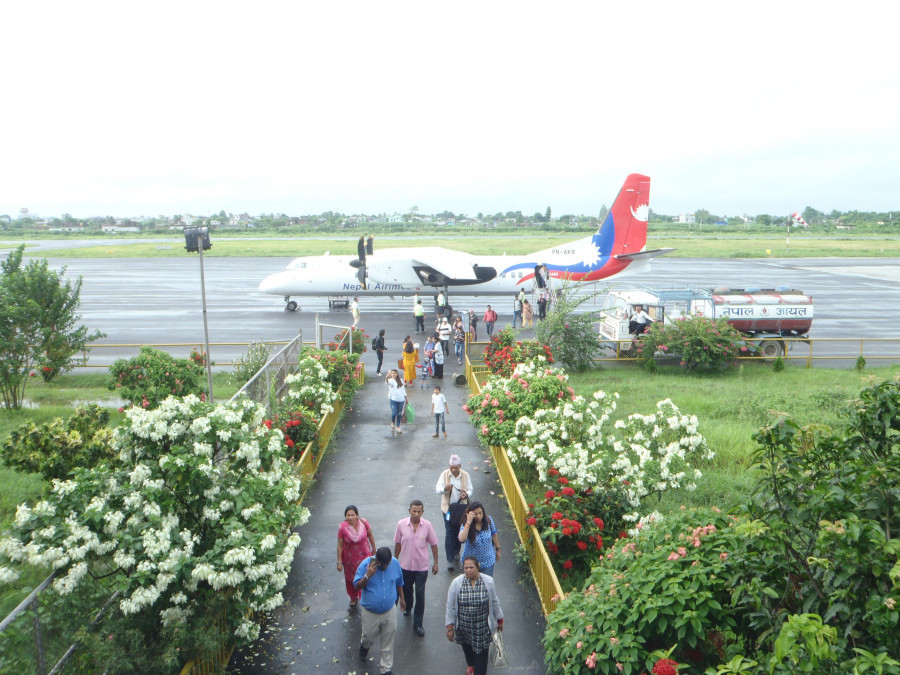Money
Biratnagar airport to get Rs15-billion facelift before going international
The runway will be lengthened to 2,500 metres, enabling it to handle jets like the Airbus A320 and the Boeing 737.
Sangam Prasain
Biratnagar airport in south-eastern Nepal is getting a Rs15-billion facelift that will add a new terminal and nearly double the length of the existing runway to upgrade to an international facility.
Construction work on the 7,000-square-metre terminal, which is estimated to cost Rs4 billion, is slated to begin this year.
Chief of Biratnagar airport Utsav Kharel said that as per the master plan, the 1,500-metre runway will be lengthened to 2,500 metres, enabling it to handle narrow-body jets like the Airbus A320 and the Boeing 737.
“But we will acquire enough land to enable us to extend the runway to 3,000 metres at a future date.”
On November 12, the cabinet granted permission to the Civil Aviation Authority of Nepal to acquire 126 bighas of land for the airport expansion project.
The airport expansion project is expected to be completed by 2024, officials said. According to Kharel, the total cost of the upgrade is expected to be upwards of Rs15 billion.
Last year, 596,453 travellers passed through Biratnagar airport, making it the second busiest domestic airport after Pokhara. There were 10,678 take-offs and landings, according to the Civil Aviation Authority of Nepal.
“The airport has tremendous potential to serve as a regional international airport connecting Bangladesh, Bhutan, Kolkata in India and even Myanmar,” said Kharel.
According to civil aviation officials, many Nepali airlines are prevented from making cross-border flights to Indian cities to bring tourists as their aircraft are too large for Nepal's domestic airports.
Kharel said that once the airport is upgraded, it will permit Biratnagar to regain its lost glory.
In 2014, Biratnagar celebrated the centenary of its birth as an industrial city. The sleepy farming town was transformed into a manufacturing powerhouse with the establishment of Biratnagar Jute Mill, the first modern factory in Nepal.
The mill was a major milestone that led to the opening of many other manufacturing plants in the city and surrounding areas. The expansion of industry resulted in the formation of the Sunsari-Morang Industrial Corridor, the country’s first industrial hub.
Once the centre of economic activities, Biratnagar is now struggling to keep its glorious past alive due to lack of infrastructure and connectivity. Despite hosting some of the largest factories in the country, the city lags behind in attracting investors.
Biratnagar airport, which opened in July 1958, is spread over 120 bighas. It is the first certified aerodrome among Nepal's domestic airports and second to Tribhuvan International Airport in Kathmandu.
According to Kharel, a preliminary survey for land acquisition has been completed. The project envisages taking over 126.46 bighas of land at an estimated cost of Rs5 billion.
The Civil Aviation Authority of Nepal, on behalf of the federal government, will put up 50 percent of the investment while the provincial and local governments will chip in 40 and 10 percent respectively, Kharel said.
“The pre-qualification process to shortlist bidders to build the new terminal has started,” said Pradip Adhikari, chief of the National Pride Projects at the Civil Aviation Authority of Nepal. “The airport will be upgraded with the view of developing it as an international airport in the near future.”
The plan to upgrade Biratnagar or Bhadrapur airport for cross-border connectivity was mooted a long time ago.
Initially, discussions were held to upgrade Biratnagar airport to a regional international airport from where flights would take off for Saidpur Airport in Bangladesh. Bhadrapur or Biratnagar to Saidpur is a 20-minute hop by plane.
Saidpur is one of the most important economic zones in Bangladesh. In 2018, the Bangladeshi Civil Aviation and Tourism Ministry started work to upgrade the airport to international class.
A joint team of Nepal’s Foreign Ministry and the Nepal-Bangladesh Chamber of Traders had also studied the possibility of establishing air links from the closest border point.




 11.12°C Kathmandu
11.12°C Kathmandu













%20(1).jpg&w=300&height=200)
